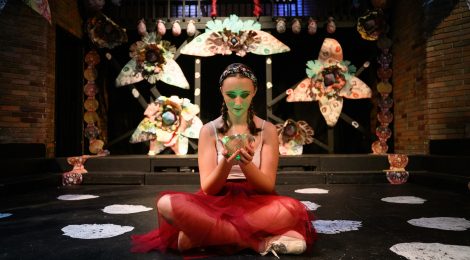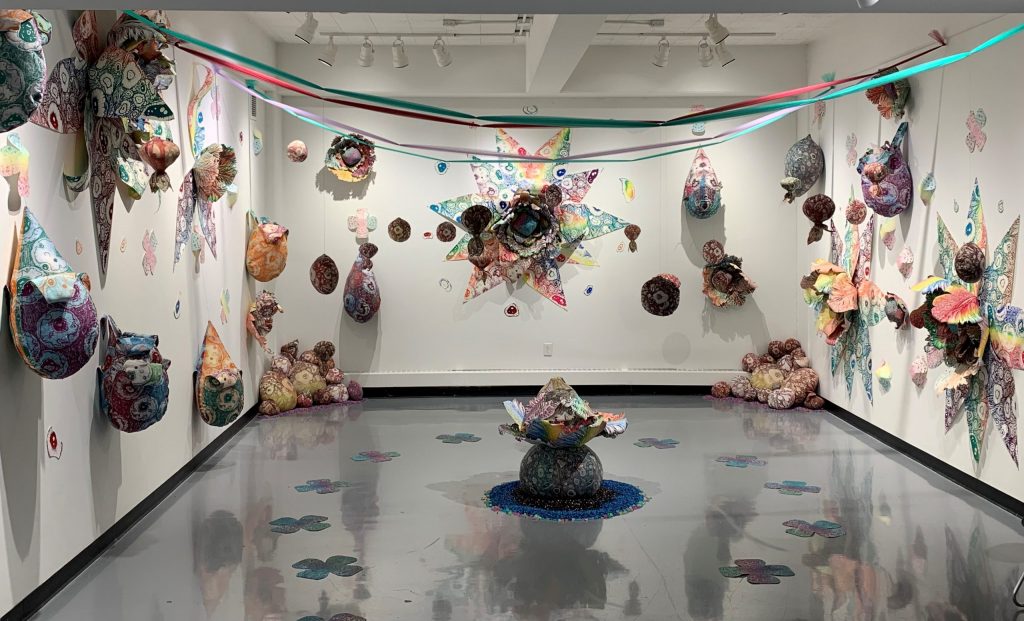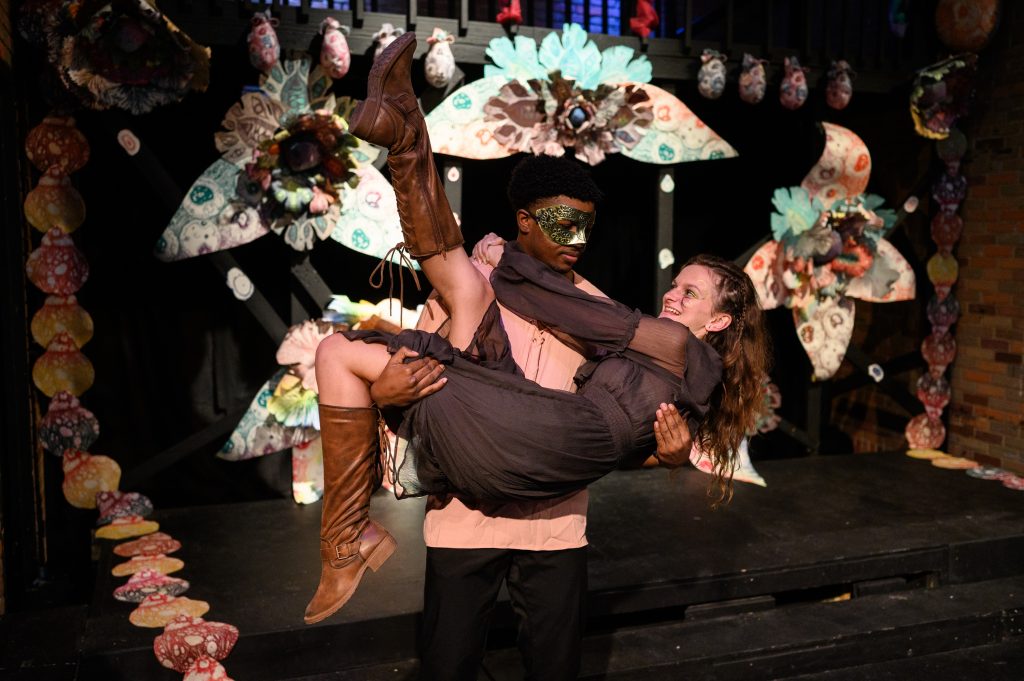
Fools, Fantasy and Florals: An Enchanting ‘Midsummer Night’ Comes to Life in the Thomas More Theatre
In fall 2024, Thomas More University’s Theatre Department presented a new production of William Shakespeare’s “A Midsummer Night’s Dream.” In an original take on Shakespeare’s classic tale of love, mischief, and magic, the staging was elevated to a new level by its intricately decorated set. Created through a collaboration with local printmaker and artist Stephanie Berrie, the 3D, floral-printed set transformed the Thomas More Theatre into a living work of art, immersing the show’s audiences in the imaginative world of Shakespeare’s beloved comedy.
The unique set came together through the concerted efforts of Berrie and Phillip Webster, director of Thomas More Theatre, and Kirk Mayhew, assistant professor of 3D arts and technical theatre at Thomas More. The origin of the partnership traces back to fall 2023, during Thomas More’s production of “Twelfth Night” – Webster’s first show at the University. He noticed Berrie installing an exhibit as a visiting artist in the Eva G. Farris Gallery, located directly across the hall from the theater. “I saw her there every night for two or three nights,” Webster recalls. “And then once it was all up – it literally just looked like ‘Midsummer’ to me, I guess I was in Shakespeare mode. I took a bunch of pictures of all her work, and then I reached out to her.”

Berrie, primarily a printmaker, had never designed an installation for a theater, but was intrigued by the offer. “I’m really inspired by nature and my surroundings, and by things that are unseen or things that are overlooked… Things that are beautiful, but when you like look closer at them, you kind of see that they’re maybe not as beautiful as they look from afar,” she explains.
For Webster, that creative vision perfectly captured the essence of “Midsummer,” and the mischief that ensues throughout the plot of the play. “‘Midsummer’ obviously has lots of magical fun elements to it. It’s definitely a comedy, and there’s a lightness to it, but ‘Midsummer’ also has a kind of darkness. Everyone basically goes out into the forest and are, in some way, shape or form, attacked by magical creatures who are sort of the embodiment of these wild, natural forces,” Webster explains. “A lot of what I liked about Stephanie’s [work]… there were these beautiful flowers that had these multi-colored leaves, but at the center of them were teeth that were coming for you. They were enticing and beautiful, but slightly dangerous. And I think that’s sort of describes much of the play of ‘Midsummer’,” he says.

The set design evolved over the next year through close partnerships between Berrie, Webster, and Mayhew, as they transformed the Thomas More Theatre into a lush, mystical forest. For the structure of the set, Webster and Mayhew had originally planned to build something entirely new, but instead decided on repurposing elements from the previous sets of two shows. “‘Midsummer’ has a lot of people who fall asleep on stage and then are supposed to wake back up on stage,” Webster explains. “You kind of have to leave them places. The other visual reason [for the setup] was we thought that might be better and easier for Stephanie’s designs to live on than what we were going with in our plan A.”
Berrie says when it came to installing her work, her goal was to create an environment that would be as immersive as possible for the audience. Focusing on this perspective, she incorporated details like vines on the theatre’s railings, hanging orbs, and floral pieces extending into the seating. “It’s always a challenge, trying to figure out how to do that with installations. In gallery settings, you’ll find that people will walk around an installation instead of walking into it… They find a path around it because people are too scared to go into the artwork. I definitely think that putting the floaty, plushy things in the audience, l kind of just forced the audience to be in it,” she explains.

The use of Thomas More’s thrust stage, which is surrounded by the audience on multiple sides, allowed the production to maximize this immersive potential. In contrast with a traditional proscenium stage, where “everything is kind of stuck inside of a TV window,” Mayhew explains, the setup in the Thomas More Theatre provides an advantage when it comes to being innovative in theatre. “I don’t know if you could pull this off this way in a proscenium style theatre. We really have this unique opportunity for the art and the story to be kind of all wrapped around the audience,” Mayhew asserts. “I don’t think we would have done this in a traditional theatre space. It just wouldn’t have been as interesting.”
Through a captivating set and the talents of Thomas More’s student actors, the audience of “A Midsummer Night’s Dream” did not just observe the play but were enveloped into its scenes. They were invited to step into a world both familiar and strange, a place where flowers might have teeth, and where love, in all its chaotic forms, unfolds in the enchanting forest.
Keep up with the latest news from Thomas More Theatre online, and by following the Department of Creative Media on social media, @thomasmore.docm. Explore more of Stephanie Berrie’s work on Instagram @berriestephanie and @wild_berries_press and at stephanieraeberrie.com.

Comments are closed, but trackbacks and pingbacks are open.